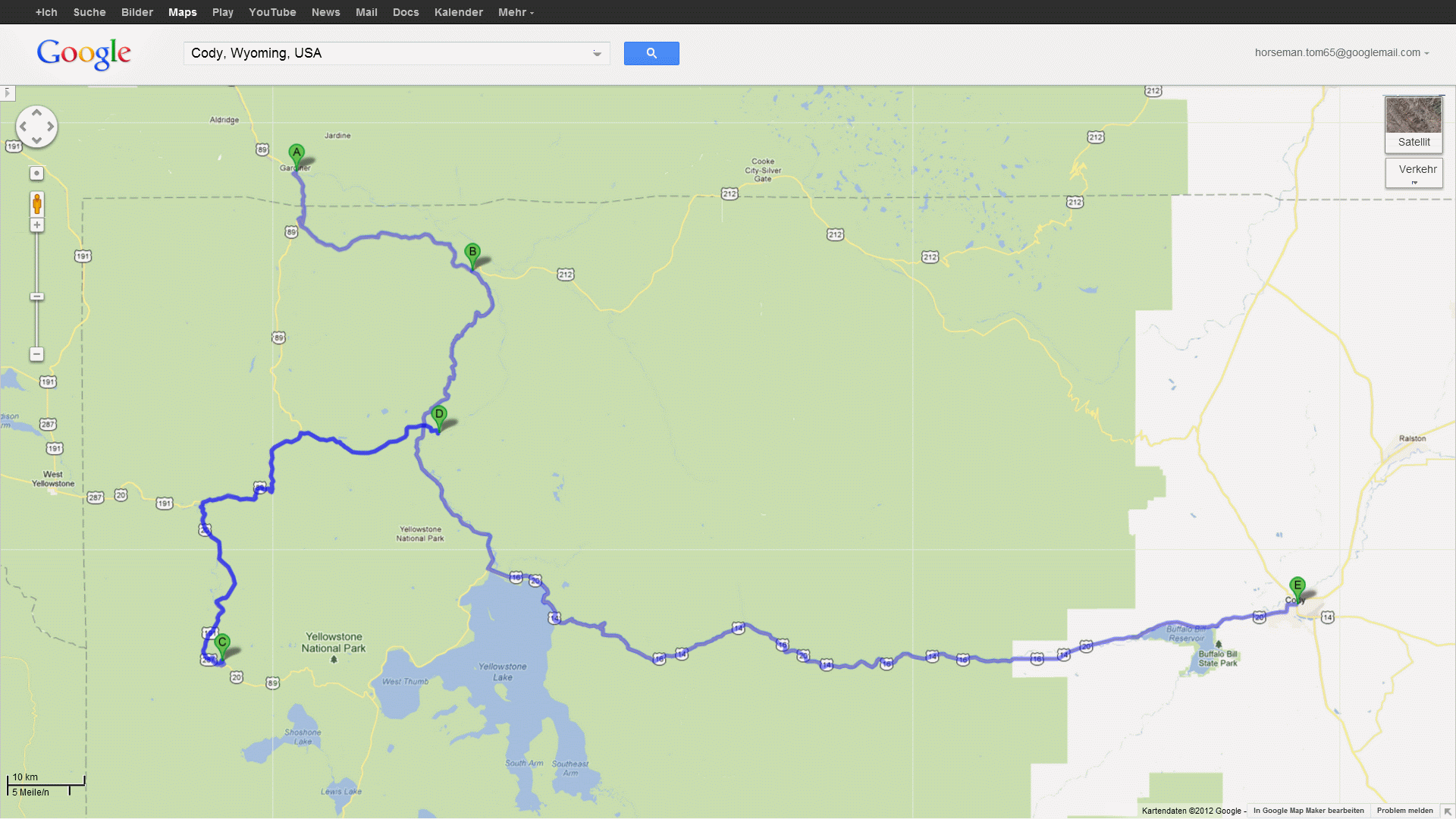Der gestrige Nachthimmel mit strahlend hellem Vollmond ließ uns erahnen, dass wir an diesem Tag mit Sonnenschein verwöhnt werden sollten… und so war es auch. 🙂 Mitten in der Nacht – um viertel nach 5 – hüpfte Tom aus den Federn und holte erst mal Kaffee, um auch Heike so halbwegs wach zu bekommen. *grins* Pünktlich zum Sonnenaufgang waren wir im Yellowstone Nationalpark angekommen. In diesem Park sind auf knapp 9.000 km2 die 3 Bundesstaaten Wyoming, Montana und Idaho vereint, wobei Wyoming mit über 90 % den grössten Teil der Fläche einnimmt. Der Park ist berühmt für seine vulkanogene Landschaft mit Geysiren, Schlammtöpfen und heissen Quellen. Ursache für die vulkanogenen Aktivitäten ist die Magmakammer des Vulkans, die das von Bergen herabfließende und im porösen Lavagestein versickernde Wasser erwärmt. In heißen Quellen, Geysiren oder blubbernden Schlammlöchern tritt das versickerte Wasser dann wieder an die Erdoberfläche. In den heißen Quellen des Yellowstone-Nationalparks leben verschiedenste thermophile Bakterien und Algen. Nur sehr wenige davon sind wissenschaftlich erforscht. Was teilweise aus diesen Erdlöchern und Tümpeln dampft, riecht stellenweise sehr unangenehm nach Schwefel. Zum Teil sind die ausgeschiedenen Substanzen hochgradig ätzend. Ziemlich schnell, nachdem man den Park von der nördlichen Seite aus befährt, sieht man es überall blubbern und dampfen. Ein unglaubliches Naturschauspiel in der aufgehenden Sonne. Auch die Tiere sind um diese Zeit besonders aktiv, was der Hauptgrund für unseren Schlafmangel war. *lach* So konnten wir im Sonnenaufgang mehrere Herden Elche und Bisons beobachten. Durchaus auch erwähnenswert sind die Wasserfälle, die aus dem Yellowstone – River und den umliegenden Gebirgsketten entstehen. Der Yellowstone – River wird gespeist vom Yellowstone – Lake. Dieser See liegt auf einer Höhe von 2.357 Meter und ist somit der höchste über 2.100 Meter (7.000 Fuss) gelegene Frischwasser – See Nordamerikas. Zum Teil wurde das Fotografieren durch die grosse Distanz zu den Tieren, die sich dort absolut in ihrem natürlichen Lebensraum befinden, zur absoluten Herausforderung für Laienfotografin Heike. Manche Leute, die uns im Park begegneten, waren allerdings „bestens ausgestattet“ – mit Stativen und Teleobjektiven so gross wie Kanonenrohre. *lach* Kaum war das Ding aufgebaut, hatte das Ziel“objekt“ auch schon die Flucht ergriffen. Da lob ich mir meine kleine Nikon, die auch auf grosse Entferungen noch – wie ich finde – tolle Bilder macht. Einige „Gesellen“ kamen uns dafür aber wesentlich näher, als uns eigentlich lieb war. *grins* Wir waren heute insgesamt 11 Stunden im Yellowstone Nationalpark unterwegs… deshalb haben wir es heute nur noch bis ins nicht weit entfernte „Cody“ geschafft. Diese Stadt wurde von William Frederick Cody, besser bekannt als Buffalo Bill, 1896 gegründet und nach ihm benannt. Hier haben wir wieder ein tolles Motel gefunden, werden jetzt einfach nur noch ins Bett fallen… und vermutlich träumen – von Elchen, Bisons, und blubbernden Quellen. Geniesst die Fotos, die ich zu einem grossen Teil unkommentiert lasse. Zu viel Geschwätz lenkt nur ab. Bis morgen, Ihr Lieben… ganz lieben Gruss von Tom und Heike 😉 – aktueller Meilenstand : 6.476 Meilen

After yesterday’s night sky with a bright full moon we expected better weather and sunshine … and it became true. 🙂 In the middle of the night – around 5:15 am – Tom jumped out of bed and got some coffee, only to wake up Heike. *smile* Just in time for sunrise, we entered Yellowstone National Park. This park covers almost 3,500 square miles of the 3 states – Wyoming, Montana and Idaho – and Wyoming takes over 90% of that area. The park is famous for its volcanogenic area with geysers, mud pots and hot springs. Cause of the volcanogenic activity, the magma chamber of the volcano, which heats the water flowing down from the mountains and is soaked by porous lava. In hot springs, geysers and bubbling mud pools, the water seeped to the surface again. In the hot springs of Yellowstone National Park you can find various thermophilic bacteria and algae. Very few of them have been scientifically researched. From those openings and ponds it smells very unpleasant like rotten egg (sulfur). Some of the excreted substances are highly acidic. Short after entering the park from the north entrance, you see everywhere the bubbling and steaming. An incredible spectacle of nature in the rising sun. Even the animals are most active at this time, which of course was the main reason for our early start causing a lack of sleep. *laugh* We were able to observe herds of elk and several buffalos in the sunrise. Most impressive are the waterfalls of the Yellowstone River and the surrounding mountain ranges. The Yellowstone – River is fed by the Yellowstone – Lake. This lake is at an altitude of 7,732 feet and is the highest over 7,000 feet located fresh water – Lake of Northern America. It was a challenge for Heike to take pictures of animals in their natural habitat. Some people we met in the park were, however, „well equipped“ – with tripods and tele-lenses as big as cannon barrels. *laugh* As soon they had set up those things, their targeted „object“ already moved away. Now I like my little Nikon that is not as big, but takes great pictures – I think so. Some of the wildlife „comrades“ came closer towards us than we actually wanted. *smile* We stayed for a total of 11 hours at Yellowstone National Park… Therefore, we just made it today to the next close town of Cody.This town was founded by William Frederick Cody, better known as Buffalo Bill, in 1896 and later was named after him. Here again we have found a great place to stay. And now we simply want to fall to bed… and probably we will dream of elk, buffalo and bubbling springs. Enjoy the pictures – some I left without comment. It would be way too much to talk about. See you again tomorrow, my dears … greetings and love, Tom and Heike 😉 – current mileage: 6,476 miles
read more / weiterlesen: 2012-05-07





















11. Mai 2012
Gorgeous pics!